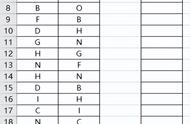双宾语结构也是一种常见结构。
如前所述,英语的简单句型,都和动词有关。
例如不及物动词和主谓结构,及物动词和主谓宾结构。

那么双宾语结构是由什么样的动词造成的呢?
授与动词。
例如我给你一件东西。I give you something.

You被给了something,算宾语吧。
Something被给了you,算宾语吧。
所以,授与动词有一人一物两个宾语。物是直接被给的,是直接宾语;人只是被给这个动作影响了,算是间接宾语。
注意,虽然you挨着give,它是间接宾语。
可以把you挪后边去,I give something to you.
间接宾语后移必须加介词to。
根据间接宾语后移时添加的介词的情况,可以分为下列几类:
To类这类动词主要有

- He handed the teacher his homework.
- He handed his homework to the teacher.
- 他把作业交给了老师。
- I showed my mother the award.
- I showed the award to my mother.
- 我向母亲展示了奖状。
- The teacher recommended me a book.
- The teacher recommended a book to me.
- 老师给我推荐了一本书。
这类动词有

注意有些动词可to可for,如do,play, sing, bring等。
- Can you find me my ruler?
- Can you find my ruler for me?
- 你能帮我找下尺子吗?
- She bought her daughter a new dress.
- She bought a new dress for her daughter.
- 她为女儿买了一件新衣服。
- I have booked you a room at a five star hotel.
- I have booked a room for you at a five star hotel.
- 我为你在五星级大酒店订了个房间。
也就是间接宾语不可后移,这类动词有charge, deny, cost, bet,envy等。
- I envy you your beautiful face.
- 我羡慕你的美丽的脸蛋。
- They charged my aunt 1000 RMB for repairing TV.
- 他们因为修电视要了我姑姑1000块钱。
这是真事,老人各种被坑。卖价3000都不到的电视,修理费要了1000.
其它类也就是在间接宾语后移时,用to和for之外的其它介词。
这类动词不多,看例句吧。
比如ask用of
- She asked me a stupid question.
- She ask a stupid question of me.
- 她向我提了一个愚蠢的问题。
比如throw用at
上课时,我打盹,老师朝我扔粉笔头。
- The teacher throw me a stick of chalk.
- The teacher throw a stick of chalk at me.
比如用on
- She played me a trick.
- She played a trick on me.
- 她对我搞恶作剧。
双宾语结构是因为动词是授予动词。
这类动词直接通过物间接作用于人,所以必须有人和物两个宾语。
有些动词的间接宾语可以移到直接宾语后,但是需要加介词。
有的加to,有的加for, 极其个别的加on、at、of。
彩蛋有一种句型很常见,就是基于双宾语结构。
He told me how to solve the equation.
他告诉我怎么解方程。
How to solve the equation作为一个名词性短语,或者句子的缩略形式,在这里是直接宾语。
这类句子可以造很多。我从简单到难排一下,下面是直接宾语从名词到短语到从句的转变。
- He told me a story.
- 他给我讲了个故事。
- He told me how to swim.
- 他告诉我怎么有用。
- He told me that they would never come.
- 他告诉我他们永远不会来了。














